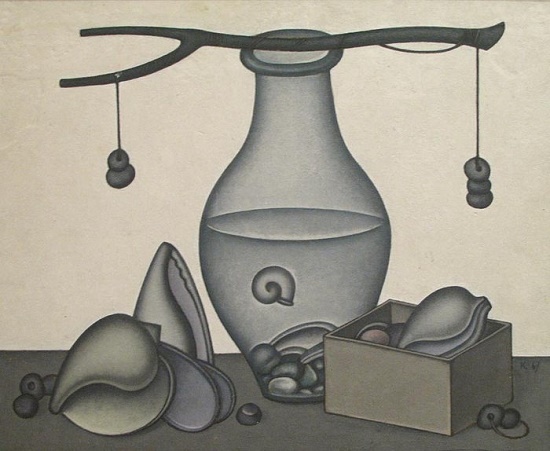Soviet Avant-garde artist Dmitry Krasnopevtsev
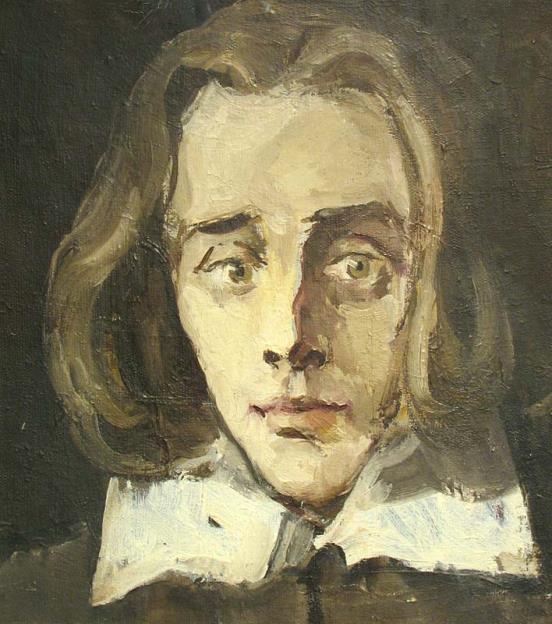
Self-portrait in make-up. Soviet Avant-garde artist Dmitry Krasnopevtsev (2 June 1925 – 28 February 1995)
Soviet Avant-garde artist Dmitry Krasnopevtsev
Born 2 June 1925 in Moscow, talented graphic artist Krasnopevtsev was a representative of “unofficial” Soviet art. Besides, one of the most significant representatives of Soviet nonconformism of the second half of the twentieth century, and the Second Russian Avant-garde.
His first works date back to the post-war era, and the style that made Krasnopevtsev a truly original artist was formed by the early 1960s. Characterizing this style, critics use the term “metaphysical still life”.
He began his studying fine arts in 1942 in the Moscow Regional Art College in memory of 1905. However, in 1943, like many of his contemporaries, he had to to go to the front. After the WWII ended, he graduated from college. Then he worked as a drawing teacher in high school, and in the period from 1949 to 1955 he again studied, but already at the Moscow State Art Institute of VI Surikov.
After training, he worked for about 20 years in the Advertising Film. Since 1976 – member of the Moscow Joint Committee of Graphic Artists, and since 1982 admitted to the Union of Artists of the USSR.
Noteworthy, in 1992, Dmitry Mikhailovich became the first artist to receive a new, “informal” Triumph award. He started to take part in exhibitions quite early, not only in Russia, but also abroad. However, when one of his still lifes appeared in the magazine “Life”, it changed his life to worse. Criticized in the Soviet press, Krasnopevtsev, accused of formalism was expelled from the Union of Artists
Accordingly, it reduced the possibility of holding further exhibitions. But thanks to friends-collectors, they began to take place in their homes. From 1950 to 1960 he actively participated in the artistic process, but later began to lead a closed way of life.

A book and a candle in a bent candlestick. 1971. Hardboard, oil
Dmitry Krasnopevtsev – a vivid representative of the metaphysical direction in the art of the generation of the “sixties”. In the early 1960s the main theme of the artist was a still life with broken ceramic utensils, fossils, dry plants, shells – a genre that combines the traditions of symbolism and surrealism. However, he began with painting and etching.
Etching in the artist’s work was not accidental: at the institute his teacher was a master of miniature etching Matvei Alekseevich Dobrov, who was the keeper of this craft. In particular, he tried to convey his secrets to his students. Engaging in such a specific kind of easel graphics, Dobrov noticed the young artist’s penchant for etching and was able to appreciate his artistic gift. He considered Krasnopevtsev one of his best students and in one of his letters even recommended him to another master of etching – Ignaty Ignatievich Nivinsky.

A candle and a broken jug. 1965
The main genre of Krasnopevtsev is “metaphysical still life”. Similar to each other, often monochrome works bring him closer to other representatives of this art. In particular, Rene Magritte, Giorgio De and especially Giorgio Morandi, with whom critics often compared Krasnopevtsev. His vision of the world, moral and aesthetic preferences did not change throughout his life, despite the fact that a significant part of it passed in complete seclusion.
Broken pitchers, vases, twigs, pebbles – in these objects the artist saw their own, invisible beauty, which he portrayed in his paintings. “Unnecessary things,” as he himself called them, can not be beautiful according to aesthetics, but the artist proves the opposite. His style of drawing turns things into symbols that have absolutely open meaning. This means that each viewer can give his work a special meaning, thus, becoming a co-author. But, perhaps, the artist simply wanted to portray the “unnecessary thing” itself, without giving it any significance. The paintings themselves attract attention, although they, more often than not – made in dark colors. He chose natural earth colors, however, it seems as if the work is shining. Thanks to this Krasnopevtsev is pretty recognizable.

1958 Still life with a hat and book
His work has received worldwide recognition, and the objects of pride of many collectors from Europe and America. But despite this, there is practically no literature about him. Over 50 years he created about 1000 paintings. Only a small part of them, as well as diaries and partly graphics were published. Creativity of Dmitry Mikhailovich is difficult to attribute to any direction or school. This is one of those artists who has his own unique manner of painting.

1970. Still life
After his death on February 28, 1995, Lidia Pavlovna Krasnopevtseva, the artist’s wife, donated about 700 items to the Museum of Personal Collections. So there was a hall “Dmitry Krasnopevtsev’s Workshop”. This is a separate room, where not only all the various works of the artist collected, but also objects that served him. In it you can see a lot of things that have nothing to do with each other. All because the collection was going on the principle of “everything, for some reason worthy of note.” Friends of Krasnopevtsev note that the workshop was for him a kind of refuge.
Soviet Avant-garde artist Dmitry Krasnopevtsev
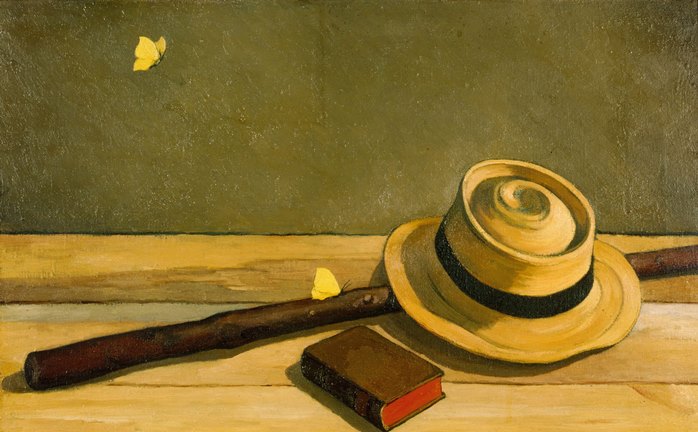
A hat and a stick, still life. 1950s

A house with a sculpture. 1949

A trunk with branches, a bowl, a jug and paper sheets. 1978. Oil on canvas

A vessel with water, stones and shells, closed from above by a large shell. 1978. Hardboard, oil

Arrows

Balance Art composition
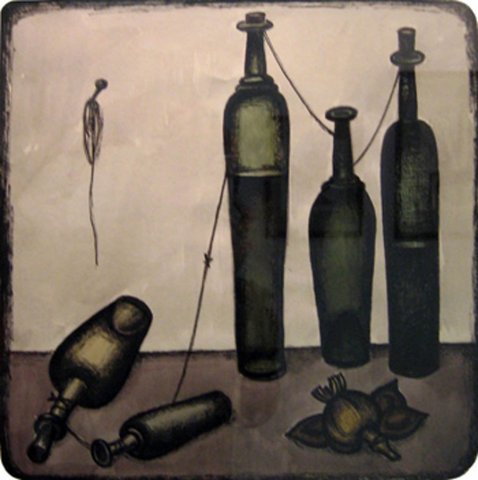
Bottles and ropes. Watercolor

Broken crramics and paper. 1976

Cactus and stars. 1957

Chicken god and a black feather. 1977. Hardboard, oil

Composition with vases and jugs. 1967

Destroyed city. 1953

Fantasy watercolors

Flood. 1949

Flower and a broken jug. 1967

Geometric flowers

In the artist’s studio. 1949. Cardboard, oil

Jail in Irkutsk. 1949

Jug, rolls and white feather on a black background. 1981

Album of paintings, cover

Nails with iron, 1959

Paris, Midnight. Lithography. 1970s

Pipes. 1963

Pitchers in the ground

Pitchers. 1970. Oil on canvas

Portrait of Reshetnikov. 1945. Oil, canvas. Artist D.M. Krasnopevtsev

Pot with flowers. Watercolor

Rain. 1954

Red crab
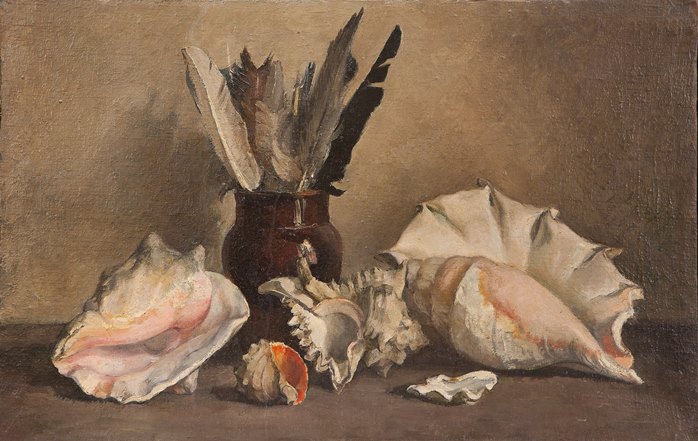
Shells, still life. 1947

Shell with red. 1958. Cardboard, oil

Soviet Avant-garde artist Dmitry Krasnopevtsev (2 June 1925 – 28 February 1995)

Still life with flower pots and skull. 1975. Hardboard, oil

Still life. 1970

Thistle
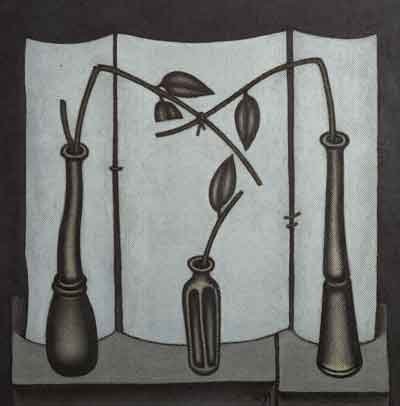
Triptych. 1993

Two ugly cracked jars on a black background. 1985. Hardboard, oil

Vase with a flower in a vessel with water. 1962 Hardboard, oil

Watercolors

White boxes. Pharmacy. 1969. Hardboard, oil

Writing desk. Watercolors

Yard. 1959
